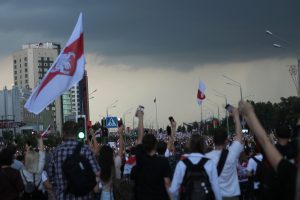European National Policies Series – Russia and Central Asia

Download “European National Policies Series - Russia and Central Asia”
Russia is a unique actor in Central Asia. It is the former colonial power and it continues to shape the future of the region. Even if Russia has lost some influence, in particular its economic leverage, it remains Central Asia’s main external player. Russia knows and accepts that it now has to share the arena with China and, to a lesser extent, with the US and some European countries, as well as a myriad of smaller actors.
Russia’s engagement in Central Asia is multifaceted yet hierarchical. Moscow’s own security is the first priority, and the threats of drug-trafficking, risk of Islamist penetration, and uncontrolled labour migration flows have to be tackled. Related to this is Moscow’s repositioning in the wake of the US/NATO withdrawal from Afghanistan, a country that is seen as an appendix to Central Asia. The second priority is maintaining Russian geopolitical influence in the region. This geopolitical clout is measured by Russia’s capacity to shape the region’s strategic orientation and limit US influence; orient the region’s economic development toward Eurasian integration to slow down the splitting up of the economic space as a result of China’s power of attraction; and cultivate networks and soft power mechanisms in the Central Asian societies.
Russia’s actions in Ukraine have both a direct and an indirect impact on Russia- Central Asia relations. Even if all Central Asian regimes endorsed the annexation of Crimea, they are concerned about a more assertive Russia that limits their foreign policy room for manoeuvre. They also fear increased pressure from Russia to join the Eurasian Economic Union and delegate part of their sovereignty to supranational organs. Meanwhile, European and US sanctions could have a negative impact, especially on Kazakhstan. But there might also be renewed economic opportunities for some sectors of the Central Asian economies: Russian firms might take a keen interest in working with their Central Asian counterparts now that working with the EU, US, Japan and others has become problematic in some sectors – such as banking and agriculture – due to the reciprocal sanctions between Russia and the West.
Political relations and values
Historically, Russia has been a crucial actor in Central Asian politics. The quantity of meetings at all levels is unmatched. However, the Central Asians often complain about being treated condescendingly by the Russians, while being received with honours in China. Russia-Central Asia political relations remain heavily stamped by the Soviet past, with common values and codes of conduct, but also a colonial tonality, which accentuates cultural misunderstandings.
Russia is not concerned with the nature of the Central Asian regimes or their poor performance with regards to public services delivery. What Russian political circles worry about is what they interpret as Kyrgyzstan’s and Tajikistan’s paths to ‘state failure’, as well as Turkmenistan’s stability. Their view of Uzbekistan is often more positive than that of the West. Russian experts think that Uzbekistan has a relatively efficient public administration and security services that will avoid ‘state failure’. As for Russia’s view of Kazakhstan, while some celebrate President Nazarbayev’s successes, others feel that the country is growing quicker than its leadership and population can cope with and that the endless investments in its energy sector might turn out to be a bubble, emphasising the country’s vulnerability. But overall, Russia is happy to make the best of all of the region’s autocratic and poorly performing regimes.
In the 2000s, Russia managed to build country-level approaches to the region. Kazakhstan enjoys a specific status within the Central Asian space and within the broader Eurasian space. It plays second fiddle to Russia in the Eurasian Economic Union (and future Eurasian Union), a role that Moscow would have liked for Ukraine. The Ukrainian crisis has reinforced Kazakhstan’s weight. However, tensions remain – although they are not publically displayed – as Kazakhstan considers that it has a right to equal status and autonomous decision-making, while Moscow would like to see it give up part of its sovereignty in favour of supranational institutions. Kyrgyzstan and Tajikistan are recipients of Russian aid and seen as client states with no room for manoeuvre. In exchange for visa-free regimes for their labour migrants (about one million Tajiks and at least half a million Kyrgyz) and some investments, Russia demands geopolitical fidelity and access for its armed forces. Uzbekistan and Turkmenistan are considered the most autonomous and difficult to influence. The latter is of no great political or geopolitical importance for Moscow, whereas the former remains a centrepiece of Central Asia’s future which Moscow hopes someday to reintegrate into its regional dynamics.
Trade and energy
Since the 1990s, trade between Central Asia and Russia has declined dramatically. Russia has lost its position as the region’s first trading partner to China. In 2013, trade between Russia and the five Central Asian states amounted to around $30 billion, whilst that with China reached $43 billion. Russia also lags behind the EU in terms of trade with Kazakhstan, and remains the first trading partner only in a few sectors with Uzbekistan and Tajikistan. Russian influence has also been challenged by the engagement of other actors such as Turkey and Iran since the 1990s, and South Korea and the Gulf countries since the 2000s.
In the field of energy, even though Russia has lost its hegemonic status, it no longer depends on Central Asian hydrocarbons: the new dynamism of Gazprom and above all of Rosneft in the Arctic region and the Okhotsk Sea have changed Moscow’s strategies, shifting the focus to its own reserves and exports. Russia’s greatest loss in Central Asia was Turkmen gas, a substantial part of which is now under China’s stranglehold. However, Russia’s main concern is not Central Asian gas going to China, but its going to Europe, which could jeopardise its own exports to the continent. Russia hopes to maintain its control over Kazakh oil exports to Europe and its transit fees, by preventing Kazakhstan from using the Caspian Sea to bypass Russia and reach European markets through Azerbaijan, the Caucasus, and Turkey.
Russia’s grip over Central Asia’s trade and energy has diminished, but Moscow still cultivates some ‘clusters’ of economic activities: it remains Kazakhstan’s main partner in the civilian nuclear industry; it is the main investor in Central Asia’s electricity market, in terms of both grids and hydropower plants; it is developing joint strategies with Kazakhstan on the cereal market; and has invested in Uzbekistan’s chemical industry and Kyrgyzstan’s textile sector. Many Russian private and public firms work in the region in the banking, pharmaceuticals, and telecommunications sectors.
More importantly, Russia has invested in regional reintegration under its leadership. The goal is both economic – to prevent the rapid splitting up of economic spaces due to China’s rise – and geopolitical – to maintain Russia’s leadership in Eurasia. The Russia-led Customs Union with Belarus and Kazakhstan, launched in 2011, has already unified customs protocols and paved the way for the forthcoming Eurasian Economic Union, which is set to enter into force on 1 January 2015. It aims to become a kind of European Union, with unified legislation and free circulation of goods, capital, and people, as well as supranational organs. However, even if these dynamics of regional integration yield benefits for the Russian economy, prospects for the Kazakh economy are not so clear cut. Kyrgyzstan and Tajikistan are also due to join in 2015, but this might be more of an economic burden than a blessing for Russia. This highlights the more political nature of the project. In order to convince potential members, Moscow points to its investment capacity and its visa- free regime.
However, in light of current Western sanctions against Moscow, it is not yet clear what benefits and pitfalls the Eurasian Economic Union will bring to Russia and other members. On the one hand, the sanctions could reinvigorate Russia-Central Asia trade in some specific sectors (Central Asia’s agricultural production might benefit from greater access to the Russian market and less competition from abroad). On the other hand, sanctions could negatively affect the Kazakh economy (standardisation of customs duties could reduce Kazakh firms access to European technologies and decrease their competitiveness). That said, some Russian firms might choose to relocate to Kazakhstan so as to avoid sanctions, thus having a rather positive impact on the Kazakh economy.
Security
Security is the main lens through which Russia looks at Central Asia. First, Russia is the world’s largest consumer of Afghan opiates and heroin, closely followed by Iran. Moscow discreetly complains about the Central Asian authorities’ lack of political will to fight drug-trafficking, and the role of corrupt local elites in covering it up or participating in it, but mostly about the US’s inability to stop drug-trafficking during its presence in Afghanistan. Russia stopped controlling the Afghan-Tajik border in 2005, but since 2012 Moscow has been asking Dushanbe to resume monitoring activities in order to curtail drug-trafficking and potential Islamist incursions. However, Tajikistan has so far refused as its ruling elites prefer to avoid Russian monitoring of their lucrative business.
Moscow’s second major security concern is the potential rise of Islamist groups in Central Asia. Russia acknowledges that this is mostly home-grown (often not directly spilling from Afghanistan). It fears that these groups could spread to Russia, penetrate the extensive labour migrant community, and connect to the North Caucasus insurgency or other Islamist groups on Russian territory.
In addition, Russia is concerned about the risk of inter-state conflicts in Central Asia around water management, inter-ethnic tensions, or unresolved border issues, even though these may be confined to the region and not affect Russia directly. In this sense, Russia’s concerns are largely similar to those of the EU and its member states.
But Russia is rather reluctant to act when tensions between Central Asian states erupt. In 2010, Russia was asked to intervene in the inter-ethnic riots between Kyrgyz and Uzbeks in southern Kyrgyzstan, but it abstained. It could not act through the CSTO, which requires an unanimous decision (Uzbekistan was against any external intervention), and decided not to intervene bilaterally so as to avoid being trapped in internal quagmires in Kyrgyzstan while risking becoming entangled in disputes between Kyrgyzstan and Uzbekistan.
Still, Russia intends to remain the region’s main security provider, especially if compared to other actors – China, the US, the EU – that play modest roles compared to Moscow. In this sense, it seeks to limit cooperation between the Central Asian states and NATO, and has bargained with the Kyrgyz government to close the US base at Manas, the only US military base in Central Asia. Cooperation between Central Asia and Western institutions is limited to the Organisation for Security and Cooperation in Europe (OSCE) and its soft security programmes, especially on border guard training and police reform. Russia wants NATO to recognise the Collective Security Treaty Organisation (CSTO) in the region as an equal counterpart, something that the Alliance partners refuse. Russia would also like to be consulted more regularly by NATO on Afghan issues and to lead the fight against drug-trafficking. However, while Russia-NATO cooperation over the Northern Distribution Network continues, other projects have been stalled by the Ukrainian crisis. Meanwhile, Moscow has also been relatively successful in slowing down the role of the Shanghai Cooperation Organisation (SCO) in the region’s security; the SCO remains a ‘paper tiger’ as Russia and the Central Asian states are weary of China having an influential role.
Russia offers Central Asian states the complete panoply of hard and soft security partnerships. Some of them are multilateral, such as the CSTO with Kazakhstan, Kyrgyzstan, and Tajikistan, while others are bilateral. All five republics can establish their own à la carte menu of requirements of Russian military assistance. Russia has two military bases in the region, one in Tajikistan and one in Kyrgyzstan, which were recently upgraded in response to changes in the strategic landscape in Afghanistan, and Russia’s strategic re-engagement in the region. Moscow also has multiple military sites and shooting ranges, and polygons to its space programme in Kazakhstan. Russia remains the main provider of military training for Central Asia’s armed forces, especially its officer corps, and security services, as well as of military material – from light weapons to heavy armament and aviation – which are often sold at Russian domestic prices. It offers joint training and exercises, including counter-terrorist operations and counter money-laundering schemes, on a bilateral or multilateral basis. Russia is also heavily involved in training border guards, especially in Tajikistan, and has participated in reforming institutions involved in disaster preparedness.
Russian engagement is not fully capable of addressing Central Asia’s real security challenges. The CSTO rapid reaction force for Central Asia, for instance, has never intervened. Many aspects of Russian security aid are criticised for maintaining former Soviet mechanisms instead of modernising the Central Asian states’ defence structures and enhancing implementation capacities. That said, no other country offers a similar, holistic security approach.
Development assistance and cultural exchanges
Russia provides some development assistance to Central Asia. However, it tends to bypass the usual, internationally codified channels, thus making its assistance more difficult to trace. Russia’s aid to the former Soviet space – its priority in terms of development assistance – runs through specific bilateral mechanisms. In 2012, Russia increased its development assistance activity, launched its own agency – RusAid – and is now considered a ‘re-emerging donor’. Its development assistance programmes overseas are increasingly implemented through international agencies such as the United Nations Development Programme (UNDP), and focus on food security and health. Moscow sees its development aid and its investments in Central Asia as development assistance mechanisms, something that many international experts contest.
Russia also offers help on a case-by-case basis during disaster situations. This has been the case particularly in Kyrgyzstan and Tajikistan. It has created many stipends to train Central Asian engineers, technicians and medical personnel. Russia is also involved in water management, but mainly through investments in hydropower projects in Kyrgyzstan and Tajikistan, all the while seeking to avoid inflaming the already tense water management situation. Last but not least, Russia claims indirectly to help to alleviate poverty in Central Asia by allowing migrants to work in Russia and send back high levels of remittances while paying few taxes. However, this is mutually beneficial, as Russia lacks cheap labour.
Russia has a distinctive soft power in the region, a legacy of the Soviet past, but it has been drastically transformed by demographic and cultural changes in Central Asia. The citizens of most of the former Soviet republics, including Central Asians, continue to look at the world through Russian eyes, as seen during the Ukrainian crisis. Russian media and cultural products continue to dominate the local scene, especially in countries with a high percentage of Russian speakers (Kazakhstan, Kyrgyzstan), or with considerable migrant diasporas (Tajikistan, Kyrgyzstan, and Uzbekistan). However, this cultural scene is evolving quickly with the generational change: elite children have access to Western culture and media, while some of the youth are more attracted to the Islamic culture and are therefore turning away from Russia. Russian cultural activities in its ‘near abroad’ are increasingly centralised by the Rossotrudnichestvo agency that tends to target Russian-speaking and Russia- oriented communities but in fact does not attract new ‘followers’. Furthermore, Russia does not invest in its soft power in Central Asia to the level that it could; Ukraine and the Baltic states have clear priority. Russia is often asked by the Central Asian states themselves to be more active, especially in the field of education (training of Russian-speaking teachers and opening of vocational schools and higher education institutions).
Recently, the Kremlin’s perceived need to boost its toolkit in its ‘information war’ with the West has given new impetus to Russia’s activities in the region. Moscow’s role in framing the local civil society and developing contacts between Central Asian and Russian GONGOs and think tanks is being intensified by the Eurasian integration project’s myriad of institutional links, although these are still at relatively superficial level. Central Asian governments themselves – foremost Kazakhstan and Uzbekistan – are also interested in promoting their ‘controlled’ civil societies, and are also seeking cooperation with their Russian counterparts, as well as with West-European and US think tanks and NGOs.
Conclusion
Western pundits who predicted that Russia would quickly vanish from the Central Asian radar after the fall of the Soviet Union were mistaken. However, Russia’s status in the region and its ability to influence these countries and their political, economic, and social trajectories has changed. Moscow has learned to deal with regimes that are concerned about their sovereignty; to share the area with other external actors; and to divide its levers of influence by country and by sector. Moscow remains a crucial player, whose decisions will shape the Central Asian region’s near future in terms of labour migration, economic integration, and strategic orientation. With the Ukrainian crisis, Moscow is ever more present on Central Asia’s radar, through its support of regimes that look favourably upon Russia and by seeking to bind them to Moscow’s interest via political, economic and military integration initiatives.
Download “European National Policies Series - Russia and Central Asia”
EUCAM-National-Policies-Brief-17.pdf – Downloaded 592 times – 465.57 KB






